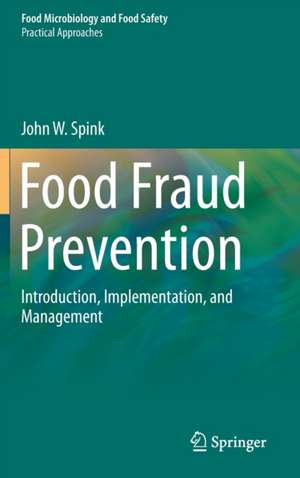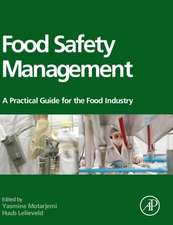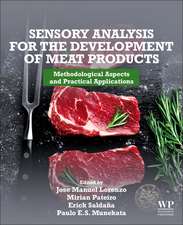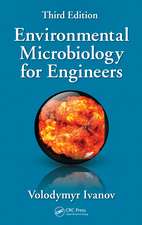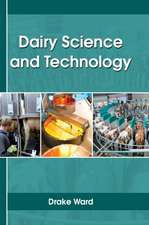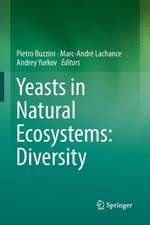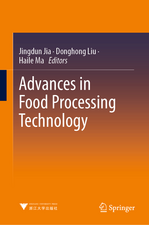Food Fraud Prevention: Introduction, Implementation, and Management: Food Microbiology and Food Safety
Autor John W. Spinken Limba Engleză Hardback – 19 oct 2019
There are now broad, harmonized, and thorough regulatory and standard certification requirements for the food manufacturers, suppliers, and retailers. These requirements create a need for a more focused and systematic approach to understanding the root cause, conducting vulnerability assessments, and organizing and implementing a Food Fraud Prevention Strategy. A major step in the harmonizing and sharing of best practices was the 2018 industry-wide standards and certification requirements in the Global Food Safety Initiative (GFSI) endorsed Food Safety Management Systems (e.g., BRC, FSSC, IFS, & SQF). Addressing food fraud is now NOT optional – requirements include implementing a Food Fraud Vulnerability Assessment and a Food Fraud Prevention Strategy for all types of fraud and for all products.The overall prevention strategy presented in this book begins with the basic requirements and expands through the criminology root cause analysis to the final resource-allocation decision-making based on the COSO principle of Enterprise Risk Management/ ERM. The focus on the root cause expands from detection and catching bad guys to the application of foundational criminology concepts that reduce the overall vulnerability. The concepts are integrated into a fully integrated and inter-connected management system that utilizes the Food Fraud Prevention Cycle (FFPC) that starts with a pre-filter or Food Fraud Initial Screening (FFIS). This is a comprehensive and all-encompassing textbook that takes an interdisciplinary approach to the most basic and most challenging questions of how to start, what to do, how much is enough, and how to measure success.
Din seria Food Microbiology and Food Safety
- 18%
 Preț: 1396.43 lei
Preț: 1396.43 lei - 20%
 Preț: 565.93 lei
Preț: 565.93 lei - 18%
 Preț: 1244.89 lei
Preț: 1244.89 lei - 15%
 Preț: 639.73 lei
Preț: 639.73 lei - 18%
 Preț: 785.86 lei
Preț: 785.86 lei - 15%
 Preț: 709.44 lei
Preț: 709.44 lei - 18%
 Preț: 951.29 lei
Preț: 951.29 lei - 18%
 Preț: 1118.75 lei
Preț: 1118.75 lei -
 Preț: 389.70 lei
Preț: 389.70 lei - 5%
 Preț: 398.11 lei
Preț: 398.11 lei - 15%
 Preț: 633.68 lei
Preț: 633.68 lei - 18%
 Preț: 1384.26 lei
Preț: 1384.26 lei - 18%
 Preț: 1486.83 lei
Preț: 1486.83 lei - 23%
 Preț: 906.44 lei
Preț: 906.44 lei -
 Preț: 389.88 lei
Preț: 389.88 lei - 18%
 Preț: 782.87 lei
Preț: 782.87 lei - 18%
 Preț: 1111.97 lei
Preț: 1111.97 lei - 15%
 Preț: 645.28 lei
Preț: 645.28 lei - 18%
 Preț: 722.58 lei
Preț: 722.58 lei - 18%
 Preț: 771.49 lei
Preț: 771.49 lei - 15%
 Preț: 712.05 lei
Preț: 712.05 lei - 18%
 Preț: 892.42 lei
Preț: 892.42 lei - 18%
 Preț: 1107.73 lei
Preț: 1107.73 lei - 15%
 Preț: 471.53 lei
Preț: 471.53 lei - 18%
 Preț: 1228.29 lei
Preț: 1228.29 lei - 18%
 Preț: 1236.51 lei
Preț: 1236.51 lei - 18%
 Preț: 1388.68 lei
Preț: 1388.68 lei - 5%
 Preț: 718.65 lei
Preț: 718.65 lei - 18%
 Preț: 1217.41 lei
Preț: 1217.41 lei - 18%
 Preț: 1386.92 lei
Preț: 1386.92 lei - 18%
 Preț: 796.76 lei
Preț: 796.76 lei
Preț: 969.13 lei
Preț vechi: 1181.87 lei
-18% Nou
Puncte Express: 1454
Preț estimativ în valută:
185.43€ • 193.63$ • 153.13£
185.43€ • 193.63$ • 153.13£
Carte tipărită la comandă
Livrare economică 15-29 aprilie
Preluare comenzi: 021 569.72.76
Specificații
ISBN-13: 9781493996193
ISBN-10: 1493996193
Pagini: 658
Ilustrații: LIV, 627 p. 117 illus., 109 illus. in color.
Dimensiuni: 155 x 235 x 38 mm
Greutate: 1.13 kg
Ediția:1st ed. 2019
Editura: Springer
Colecția Springer
Seriile Food Microbiology and Food Safety, Practical Approaches
Locul publicării:New York, NY, United States
ISBN-10: 1493996193
Pagini: 658
Ilustrații: LIV, 627 p. 117 illus., 109 illus. in color.
Dimensiuni: 155 x 235 x 38 mm
Greutate: 1.13 kg
Ediția:1st ed. 2019
Editura: Springer
Colecția Springer
Seriile Food Microbiology and Food Safety, Practical Approaches
Locul publicării:New York, NY, United States
Cuprins
Chapter 1: Introduction (Part 1 of 2): Food Fraud Definitions and Scope.- Chapter 2: Introduction (Part 2 of 2): Basic Prevention Concepts.- Chapter 3: Food Fraud Prevention Overview (Part 1 of 3): Basics.- Chapter 4: Food Fraud Prevention Overview (Part 2 of 3): The Approach.- Chapter 5: Food Fraud Prevention Overview (Part 3 of 3): The Implementation.- Chapter 6: Business Decision Making and ERM/COSO.- Chapter 7: Criminology Theory (Part 1 of 2): Foundational Concepts.- Chapter 8: Criminology Theory (Part 2 of 2): Application Review.- Chapter 9: Supply Chain Management (Part 1 of 2): Fundamentals.-Chapter 10: Supply Chain Management (Part 2 of 2): Application Applied to Food Fraud Prevention.- Chapter 11:Standards & Certifications (Part 1 of 2): The Role of the Public Private Partnership.- Chapter 12: Standards & Certifications (Part 2 of 2): Global Food Safety Initiative (GFSI).- Chapter 13: International Public and Private Response.- Chapter 14: Marketing, Competitive Strategy,and Competitive Intelligence.- Chapter 15: Risk Analysis (Part 1 of 3): Basic Fundamentals.- Chapter 16: Risk Analysis (Part 2 of 3): Application to Food Fraud.- Chapter 17: Risk Analysis (Part 3 of 3): Implementation.- Chapter 18: Conclusion.- Back Matter.
Notă biografică
The concepts in this book are based on the practical application experience and peer-reviewed journal publications of Dr. John Spink, who is the Director of the Food Fraud Initiative and an Assistant Professor in the Eli Broad College of Business at Michigan State University. His vulnerability-reducing research focus started in 2006 with intellectual property rights counterfeiting, and then expanded to all types of product fraud. In 2013 his focus shifted primarily to food fraud. He is the most widely published author regarding food fraud prevention, with fundamental works such as the 2011 “Defining the Public Health Threat of Food Fraud,” the 2013 “Defining the Types of Counterfeiters, Counterfeiting, and Offender Organizations,” the 2016 “Introducing the Food Fraud Initial Screening model (FFIS),” the 2019 “Introducing the Food Fraud Prevention Cycle (FFPC)” and the 2019 “Food Fraud Prevention: Overview and Requirements to Address ’How to Start?’ and ‘How Much is Enough?’” Hisleadership positions include product fraud related activities such as with “ISO 22000 Food Safety” and “TC292 Security Management/ Fraud Countermeasures,” GFSI Food Fraud Think Tank, and U.S. Pharmacopeia (USP). Global activities include engagements with the European Commission, INTERPOL and Operation Opson, Food Safety Authority of Ireland (FSAI), UK National Food Crime Unit (NFCU), New Zealand MPI, Codex Alimentarius, WHO/FAO, INFOSAN, the Codex Alimentarius Electronic Work Group on Food Fraud, Trinidad & Tobago Ministry of Agriculture, ISLI, AOAC, and served as an Advisor on Food Fraud to the Chinese National Center for Food Safety Risk Assessment (CFSA).
Textul de pe ultima copertă
This textbook provides a foundation for the theories and concepts to fully develop, implement, and manage a Food Fraud Prevention Strategy. The scope of focus includes all types of fraud (from adulterant-substances to stolen goods to counterfeits) and all types of products (from ingredients through to finished goods at retail). The root cause analysis is focused to combat the human adversary is based on Criminology Situational Crime Prevention theory. The overall prevention strategy expands fully through the system to the final resource-allocation decision-making based on the COSO principle of Enterprise Risk Management/ ERM. The content includes a detailed review of the Food Fraud Definitions and Scope, Basic Prevention Concepts, a thorough presentation of the Food Fraud Prevention concepts and approach, the application of Business Decision Making and COSO based Enterprise Risk Management ERM, Criminology Foundational Concepts then an Application Review, Supply Chain Management Fundamentals and then Application, a review of The Role of the Public Private Partnership, Standards & Certifications with a focus on the Global Food Safety Initiative (GFSI), International Public and Private Response, Michael Porter theory based Marketing and Competitive Strategy, and finally a thorough review of Risk Analysis Basic Fundamentals and Implementation that includes full vulnerability assessment examples. The overall system is managed within the Food Fraud Prevention Cycle (FFPC) and starts with a pre-filter or Food Fraud Initial Screening (FFIS).
Caracteristici
Puts forth a holistic, all-encompassing approach to food fraud Provides an overview of food fraud, including economically motivated adulteration, intentional adulteration, and counterfeiting? Brings to the public eye the relatively new concept of food fraud prevention
